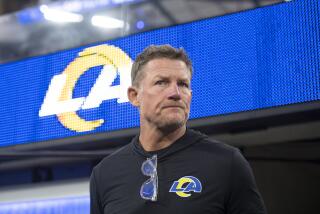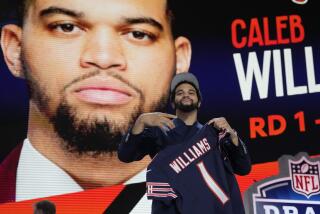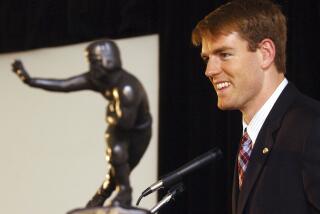Going From Mr. Right to Mr. Wrong
- Share via
They come out of college football with impeccable credentials, proudly labeled “can’t miss” players. They are All-This and All-That, equipped with all the tools they need to succeed.
They are probed and picked at by the scouts, twisted and turned every which way, like so many laboratory specimens. Then the glowing reports are delivered to the clubs.
Great hands. Great speed. Great prospect. But that’s all they are--prospects. And sometimes, great expectations turn into sour reality. It happened more than once in the ‘80s and it will happen again today when the NFL conducts its annual draft. The trick for each of the 28 clubs is to make sure it doesn’t happen to them.
The spectre of washout picks hangs over the clubs like a bad dream. You feel sorry for the other guy when a pick goes south, but at the same time, you’re grateful that it didn’t happen to you.
Personnel people still talk about the great quarterback draft of 1983, when the clubs found a bumper crop of signal callers waiting for them. The first one to go, the No. 1 pick in that draft, was John Elway of Stanford. No miss there.
Five non-quarterback picks later, it was Kansas City’s turn. The Chiefs used the seventh choice in the draft to select passer Todd Blackledge of Penn State. To say that selection didn’t quite work out would be, well, putting it mildly.
By picking Blackledge, KC left behind Jim Kelly, scooped up by Buffalo, Ken O’Brien, taken by the New York Jets, Tony Eason, chosen by New England and--perhaps most significantly--Dan Marino, who went to Miami.
Elway, Eason and Marino have taken their teams to the Super Bowl. Kelly had the Bills in the AFC championship game last season. O’Brien remains the Jets’ starter. After five disappointing years in Kansas City, Blackledge was dispatched to Pittsburgh, where he remains a backup to Bubby Brister, a less-heralded 1986 third round choice of the Steelers.
There are other examples.
In 1981, New Orleans turned to the wrong Carolina for the draft’s No. 1 pick. With North Carolina linebacker Lawrence Taylor on the board, the Saints went instead to South Carolina for running back George Rogers.
Rogers won a rushing title but played just four years with New Orleans before being traded to Washington and then drifting out of football. Taylor, drafted by the New York Giants, became the anchor of their defense and the NFL’s MVP in 1986. He remains one of the league’s impact players.
In 1984, the Cardinals, then in St. Louis, were shopping for speed and used their No. 1 pick, the 17th selection overall, to pick wide receiver Clyde Duncan.
Duncan had speed, all right, but bad hands to go with it. He was cut--not only by the Cardinals, but even by one of the 1987 strike replacement teams, difficult to do since those clubs were accepting just about anyone who knew how to put on pads and a helmet.
How does that happen? How does a high pick that seems so right turn out to be so wrong? Gil Brandt, vice president for player personnel of the Dallas Cowboys who has been in the business of evaluating football players for more than 30 years, chuckled at the question.
“Sometimes, teams draft to fill a position,” he said. “They’ll say, ‘If we don’t draft him in the first round, he won’t be there in the second.’ Some positions are hard to find.”
So, when Denver was determined to get a nose tackle last year, it went sight unseen for Ted Gregory of Syracuse--ignoring his slow recovery from knee problems and his lack of size. He reported late to training camp and left early, traded by the disappointed Broncos to New Orleans for Shawn Knight, another failed No. 1.
This year, the Broncos decided to take no chances and, like most other teams, got up close and personal examinations and evaluations of their draft candidates.
“Sometimes you reach for something that’s not there,” Brandt said. “You pass on a better player to fill a need and you can get burned. We’ve done the same thing.”
Which may explain why the Cowboys have the No. 1 pick today.
The draft is now a high tech operation that Brandt compares with the difference between “flying DC3s and Convairs with 747s.”
More to Read
Go beyond the scoreboard
Get the latest on L.A.'s teams in the daily Sports Report newsletter.
You may occasionally receive promotional content from the Los Angeles Times.










